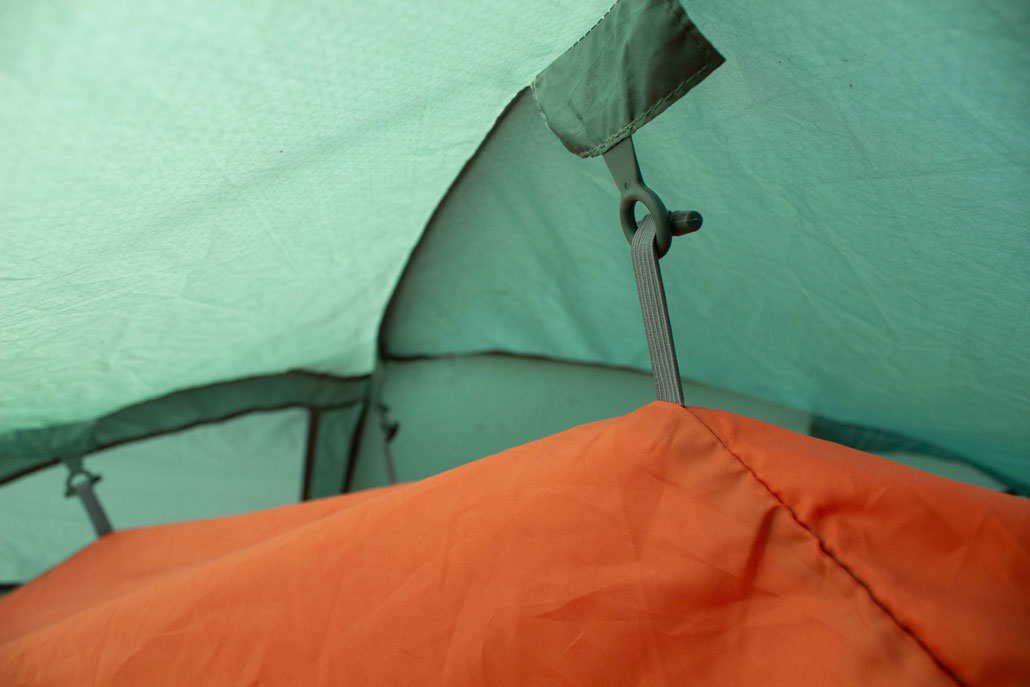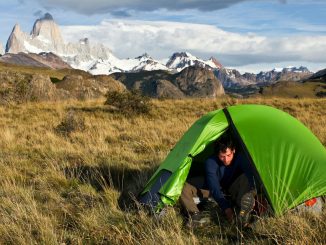
If you’re planning on spending a lot of time camping in the rain, this is the tent you want to be in. A solid, semi-geodesic structure, trail weight of 3.89kg and true 3-person sizing, makes it the perfect wilderness tent for a team of three.
Update: The Vango Halo Pro 300 seems to have replaced the standard version locally, but for all intents and purposes, the review is still perfectly applicable. The Pro version retails for R6995 (at time of update).
Quick specs
Size: 3-person
Weight: 3.89kg (without storage bag)
Waterproof rating: Flysheet: 5000mm HH; Groundsheet: 6000mm HH
Structure: Semi-geodesic: 3 poles, 2 crossings
Price: R4750 (at time of writing)

Features
The Halo 300 is feature-rich with a bunch of well-designed elements. Here are a couple that really stood out:
Flysheet-first pitching: If you’ve ever had to pitch your tent in the driving rain, you’ll know that by the time you finally get your fly sheet on, your tent is completely soaked on the inside. Vango have overcome this problem by running the tent poles through sleeves on the outside of the flysheet, while attaching the inner tent by means of toggles.

This also allows you to pitch the flysheet on its own, as a shelter, to just get out of the rain for a bit.

Door storage pouch: Instead of having the usual toggle system to tie the door down when open, Vango have created a triangular storage pouch for the door to be stuffed into. This might sound like a minor, but it is surprising how noticeable it is, not having to fiddle with toggles every time. The storage pouch is made possible by the O-shaped doors, which not only makes for very easy, one-handed opening and closing, but also allows loose door fabric to be collected in one, small area.

Corner storage pockets: The storage pockets are located in the corners, halfway up the inside of the tent. This allows floor space to be used maximally, by not having bulging pockets by your head or feet.
Equalized guy lines & Line-Lok runners: There are two guy lines for each of the 6 pole endings, making 12 points of contact. The two guy lines are equalized, per pole, through an O-ring, which assures maximum tension on each guy line. The tension adjustment is also made very easy with the quick-release Line-Lok guy line runners.

Twin flysheet door zips: The flysheet doors have bi-directional zips that allow you to open the door from the top to ventilate the vestibule area.
Weight
Advertised as 4.13kg total weight, I found that removing the storage bag and only weighing the inner tent, the flysheet, poles and pegs (i.e. trail weight), brought the total weight down to 3.89kg.
Ease of pitching
The tent poles are identical which simplifies the setup process even more (this demo model had a pole replaced, hence the different colours). The tent can be pitched with the flysheet first, or all-in-one with the tent-inner pre-attached. Pitching the tent all-in-one makes for a speedy setup and guarantees a dry inner. Without any type of pitching instructions, it took me just under 11 minutes to pitch the tent for the first time, with all the peg-points and guy lines fixed.

The sleeping quarters
I’ve gotten used to advertised tent sizing to be on the small side, i.e. 2-person means 1.5-person and 3-person means 2.5. The Halo 300 is true 3-person sizing. The ample sleeping space, combined with two big vestibules means everyone and their gear can be kept dry.

Entrance and vestibules
Dual entrances allow for easy access, or ideal storage space for backpacks while still leaving one entrance unobstructed. Also, in strong wind or driving rain, the choice of entrance makes for much more pleasant tent-life.

The inner doors have a half-height mesh panel, as opposed to the usual full, extra mesh panel. This saves weight and is also less hassle than having to tie up the second door panel.
The vestibules are large, allowing for comfortable, sheltered cooking outside the tent while still being sheltered from the elements.
Overall construction
The tent construction is a semi-geodesic, self-supporting structure, providing an excellent balance between weight and stability.

The highly waterproof and durable Protex® 70D 5,000mm HH Polyester Flysheet, combined with Vango PowerLite 7001-T6 lightweight and durable alloy poles, just screams longevity. This tent feels like it will stand up to a lot of abuse. Just to be sure, we parked it in the driving rain for 6.5 hours and the inside of the flysheet remained bone-dry.
Both the flysheet and tent-inner are made from fire retardant fabrics that meet the European EN5912 safety standard.
The tent was supplied for review by Ram Mountaineering Gear and can be purchased online from Mountain Mail Order or Drifters.
A tent-specific footprint (groundsheet) can be purchased separately.





Thank you for a great and informative review! May I hint at the possibility of a review of the Nemesis pro 300?
We’ll definitely chat to the supplier 😉
Hi, that was a great review. We are the agents for Hilleberg tents in SA and would like to expand the exposure.
Hi, I have this tent but have lost the poles – is there any way that you know of to get a replacement set??
Or if not, would you be able to tell me the length of the poles so I can make a set with kits?
You can contact Ram Mountaineering – they are the distributors for Vango: +27 21 532 0549 / info@rammountain.co.za
Is this tent suitable for Winter?
Definitely
Excellent review. Vango tents are good value money, I have the Banshee pro 200 and slept in some awful weather and was bone dry.